Hi @Levi1129
Thank you for posting your question in the community.
I think this is an interesting question. My initial thought would be to assess the purpose of the flow and each email in the flow as to whether or not another message is needed.
For example, if your email series is meant to drive conversions, I’d look at the placed order rate. If the placed order rate continues to be high for each email in the message, then you want to add a message to extend it.
Now, in the context of removing a message, If you see the placed order rate is low, that doesn’t necessarily warrant removing the message (in my opinion) because it is still driving some revenue.
I think click rate is a good measure to look at, but I’d also look at unsubscribe, spam compliant, and conversion rates. But rather than remove the message altogether, if you see an email with a low click rate, or high unsubscribe rate, this is an indication of:
- If click rates are low it could be a measure of the content, it could be an opportunity to optimize the call to action, etc.
- The content at that moment isn’t hitting the right mark and people are becoming annoyed (unsubscribing) or not valuable enough (not clicking)
- The cadence of the series could be optimized (if people are receiving too many emails from you, its an opportunity to assess the cadence of the series and possibly enabling some Smart Sending)
But again, it all comes down to the purpose of the flow/message. If you come across a message that doesn’t seem to be driving towards the flow goal, then you could remove it, or restructure the content to be inline with the purpose.
I hope this helps! That said, I’d like to invite my fellow Klaviyo Champions to chime in with their thoughts and perspectives: @Omar @Bobi N. @retention @Akers Digital @chelsgrove @Spark Bridge Digital LLC @Ashley I. @inboxingmaestro @ebusiness pros @KatherineB @Kylie W
Best,
@In the Inbox
HI @Levi1129 thanks for posting!
@In the Inbox had some great suggestions and I definitely agree about the deliverability metrics. I would look at this in addition to click rate and POR - if you notice higher spam complaint rates or unsubscribe rates after a particular email in a flow, look at the following emails too. Are they driving enough revenue to warrant the possible deliverability headache if they are increasing negative deliverability metrics?
Hi @Levi1129 - this is one my favorite kinds of questions to see in the community!
@In the Inbox and @KatherineB gave you useful insights on how to prioritize which metrics you use to evaluate the performance of each email in a given flow.
Once you’ve evaluated the KPIs for each email, and established the status quo of how the flow has been performing, it’s also important to consider the overall customer journey/ UX that you’re creating within the whole system of all the flows this brand has.
Each flow interacts with another in some way. For example: a Welcome Series flow might lead someone to an Abandoned Checkout flow, or if they purchase immediately, it would lead them directly to a New Customer Thank You flow instead. Once someone becomes a customer, they might eventually enter a Cross-Sell flow, or a Customer Winback flow, and if they order again, they might then go into a Repeat Customer Thank You flow.
For some people, this plays out over months. For others, this might play out over weeks. Generally, you don’t want flows to overlap with each other - this can lead to things like people feeling confused about what they’re shopping for/ what they purchased, or annoyed by multiple emails in the same day, or both.
So one of the most important things to keep in mind is what happens once someone converts, or takes the action you’re using as the “goal” for each flow? For example: In most cases, once someone places an order, they can be filtered out of a Welcome Series flow since it’s not important for them to get those emails anymore. Instead, you’d focus their attention on the New Customer Thank You flow that they’re starting to receive.
The people who take longer to research or decide to make a purchase will likely receive all emails in a Welcome Series flow. In which case, maybe the status quo version doesn’t have enough emails, or it has too many, but it’s difficult to accurately assess the performance of the last few emails in a flow if everyone is being sent those emails, regardless of whether or not they’ve already purchased or the emails are still relevant.
One of the first refinements I’d make is narrow the focus of who gets what emails, and when someone should exit a flow so their attention can be focused on another flow. That simple change might give you more insight into how “well” the last email in a flow performs, once it’s more specifically sent to people who truly need it.
Warmly,
Gabrielle
Klaviyo Champion & Marketing Lead at ebusiness pros
